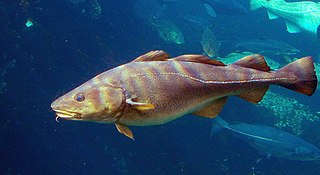
Perciformes, also called the Acanthopteri, is an order or superorder of ray-finned fish in the clade Percomorpha. Perciformes means "perch-like". Among the well-known members of this group are perch and darters (Percidae), sea bass and groupers (Serranidae).

The Tetraodontiformes are an order of highly derived ray-finned fish, also called the Plectognathi. Sometimes these are classified as a suborder of the order Perciformes. The Tetraodontiformes are represented by 10 extant families and at least 349 species overall; most are marine and dwell in and around tropical coral reefs, but a few species are found in freshwater streams and estuaries. They have no close relatives, and descend from a line of coral-dwelling species that emerged around 80 million years ago.

Cod is the common name for the demersal fish genus Gadus, belonging to the family Gadidae. Cod is also used as part of the common name for a number of other fish species, and one species that belongs to genus Gadus is commonly not called cod.

A flatfish is a member of the ray-finned demersal fish order Pleuronectiformes, also called the Heterosomata, sometimes classified as a suborder of Perciformes. In many species, both eyes lie on one side of the head, one or the other migrating through or around the head during development. Some species face their left sides upward, some face their right sides upward, and others face either side upward.

The Scorpaeniformes are a diverse order of ray-finned fish, including the lionfishes and sculpins, but have also been called the Scleroparei. It is one of the five largest orders of bony fishes by number of species, with over 1,320.

Groupers are fish of any of a number of genera in the subfamily Epinephelinae of the family Serranidae, in the order Perciformes.

The school shark is a houndshark of the family Triakidae, and the only member of the genus Galeorhinus. Common names also include tope, tope shark, snapper shark, and soupfin shark. It is found worldwide in temperate seas at depths down to about 800 m (2,600 ft). It can grow to nearly 2 m long. It feeds both in midwater and near the seabed, and its reproduction is ovoviviparous. This shark is caught in fisheries for its flesh, its fins, and its liver, which has a very high vitamin A content. The IUCN has classified this species as critically endangered in its Red List of Threatened Species.

The Microdesmidae, the wormfishes and dartfishes, were a family of goby-like fishes in the order Gobiiformes, more recent workers have placed this taxon within the Gobiidae, although the researchers do not define the taxonomic status of this grouping within that family. Two subfamilies in this family were briefly treated as full families - the Ptereleotrinae (dartfishes) and Microdesminae (wormfishes). The family includes about 82 species.

Dartfishes are a group of fish, formerly considered to be a subfamily, Ptereleotrinae, of goby-like fishes in the family Microdesmidae of the order Gobiiformes, Authorities now consider the species in the family Microdesmidae are within the Gobiidae, although the researchers do not define the taxonomic status of this grouping within that family. They are saltwater fish.

The Gobiiformes are an order of fish that includes the gobies and their relatives. The order, which was previously considered a suborder of Perciformes, is made up of about 2,211 species that are divided between seven families. Phylogenetic relationships of the Gobiiformes have been elucidated using molecular data. Gobiiforms are primarily small species that live in marine water, but roughly 10% of these species inhabit fresh water. This order is composed chiefly of benthic or burrowing species; like many other benthic fishes, most gobiiforms do not have a gas bladder or any other means of controlling their buoyancy in water, so they must spend most of their time on or near the bottom. Gobiiformes means "goby-like".
Springeratus caledonicus, the Caledonian weedfish, is a species of clinid found around New Caledonia and Australia. This species placement in the family Clinidae has been questioned with some feeling that it is best placed in the family Microdesmidae.

Nemateleotris is a genus of dartfishes native to the Indian and Pacific oceans.
John Ernest "Jack" Randall was an American ichthyologist and a leading authority on coral reef fishes. Randall described over 800 species and authored 11 books and over 900 scientific papers and popular articles. He spent most of his career working in Hawaii. He died in April 2020 at the age of 95.
Navigobius is a genus of fish in the family Microdesmidae native to the Indo-Pacific Ocean.

Oxymetopon is a genus of fish formerly classified in the family Microdesmidae but now classified in the Gobiidae. They are native to the western Pacific Ocean. They are sometimes called ribbon-gobies.
Zagadkogobius ourlazon is a species of fish in the family Microdesmidae native to the deep-water of southwestern South China Sea. This species is the only member of its genus.

Istiophoriformes are an order of bony fish which is not fully recognized by some taxonomists, with some including the two extant families Xiphiidae and Istiophoridae, and others, including the family Sphyraenidae.

Goby is a common name for many species of small to medium sized ray-finned fish, normally with large heads and tapered bodies, which are found in marine, brackish and freshwater environments.
William Albert Bussing, known as Don William, was an American ichthyologist who spent most of his career on the faculty of the Universidad de Costa Rica, working there from 1966 to 1991. He was appointed professor in 1978 and when he retired he became emeritus professor.

Ptereleotris randalli, the Brazilian dartfish, is a fish belonging to the family Gobiidae and subfamily Ptereleotrinae. Like other dartfishes, it lives over sand and rubble bottoms, and quickly retreats into holes when approached. It was originally thought to be restricted to Brazil, south to Santa Catarina, but recently reported for the southern Caribbean, where it's found at depths of 8-60m.













